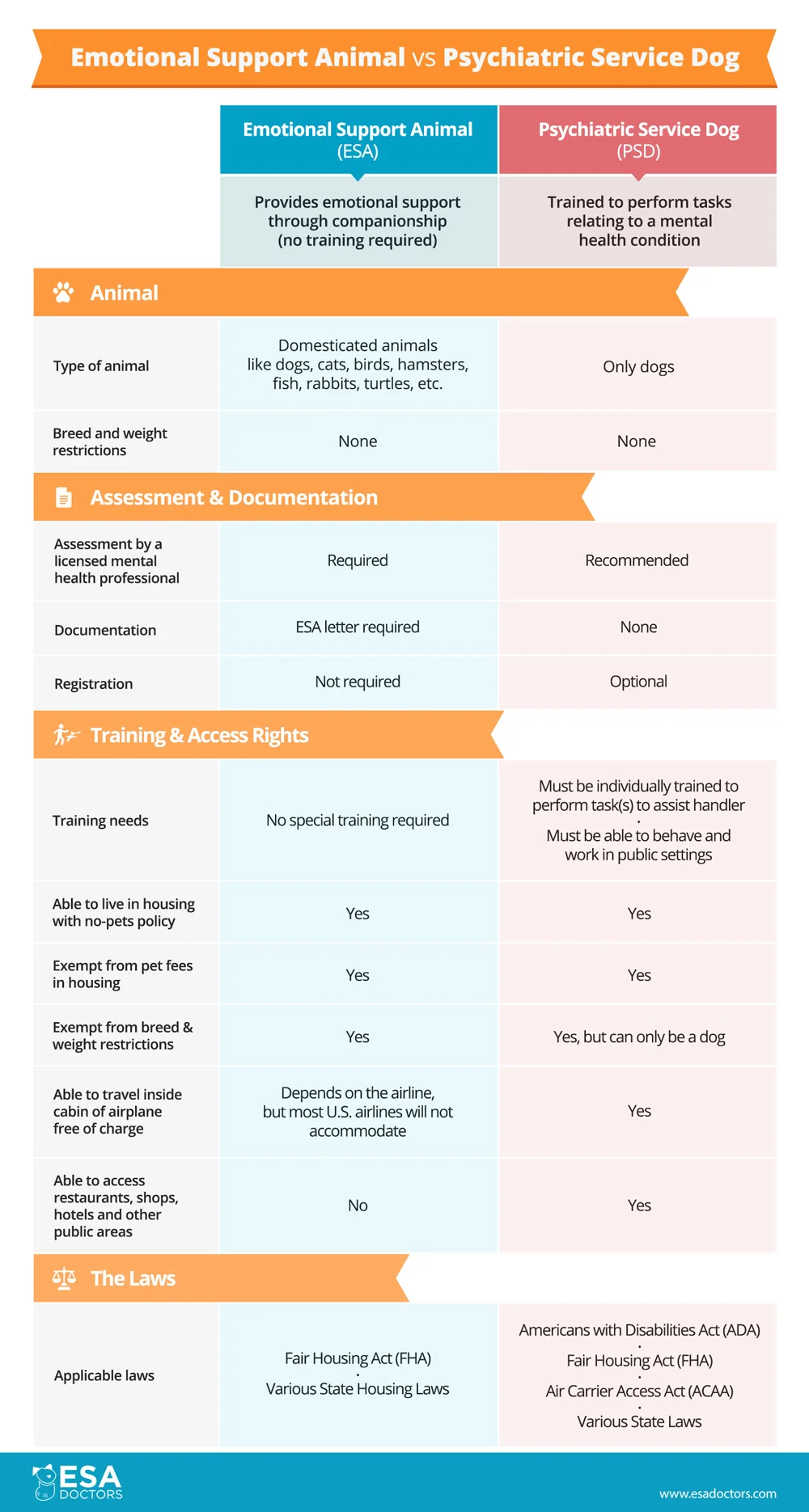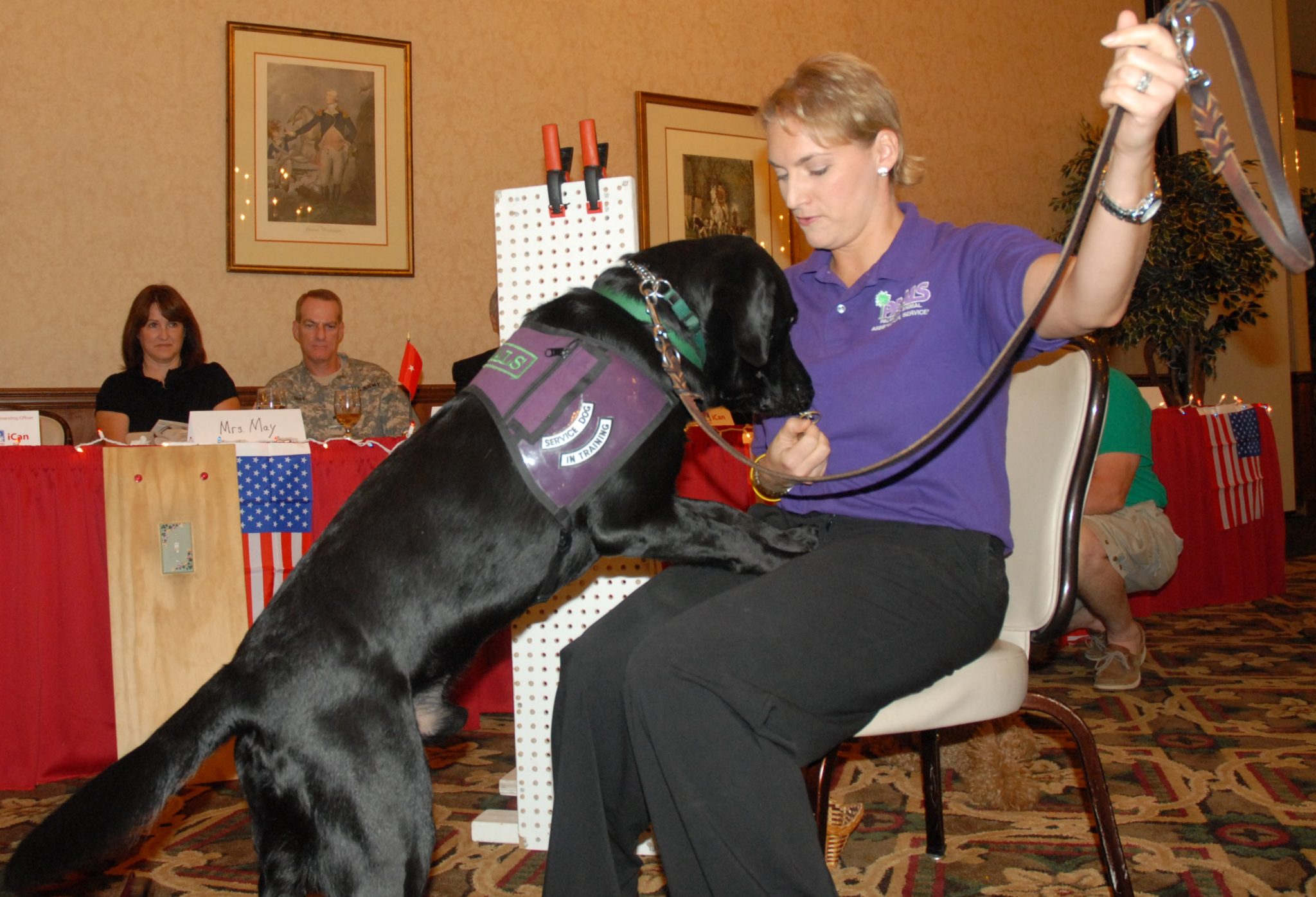Any dog owner knows having a dog around can make life brighter. For people who have an emotional or mental disorder, the benefits of owning a dog go beyond tail wagging and face licking—their dog can help save their life. Emotional support animals and psychiatric service dogs are two types of assistance animals that may help their handlers overcome the hardships of their disability. Recent changes in the law have many emotional support animal handlers wondering if they would qualify for a psychiatric service dog. Although that is not impossible, there are several points to consider, as this article will explain.
Types of Assistance Animals for Emotional or Mental Disabilities
There are two categories of assistance dogs that primarily serve people with emotional or mental disabilities:
1. Emotional Support Animals
An emotional support animal (ESA) can be any animal, such as cats, hamsters, rabbits, fish, iguanas, but people tend to opt for dogs. These animals offer companionship, comfort, and a stabilizing presence in the lives of people with emotional or mental disorders.
To qualify for an ESA, an individual needs to undergo an assessment by a licensed mental health professional. If the therapist agrees that an animal can positively influence the person’s mental health, they will issue an ESA letter. A legitimate ESA letter grants the individual an emotional support animal for one year, after which a re-assessment is required.
ESAs fall under federal protections in the Fair Housing Act (FHA) under HUD and can reside with their handlers in housing with a no-pets policy, free of extra charge.
Want to know if you qualify for an emotional support animal?
Get your ESA letter online. Complete the ESA letter questionnaire here.

2. Psychiatric Service Dogs
Psychiatric service dogs (PSD) go beyond providing companionship and comfort. Unlike emotional support dogs, they are specifically trained to perform a task that helps their handler with their disability. A psychiatric service dog might receive months of training to learn how to intervene during a person’s mental health crisis. For example, some psychiatric service dogs can identify self-harm behaviors and stop their handlers or get help.
To own a PSD, handlers do not need any official letter from their therapist, although a conversation with a doctor may help to identify the tasks the service dog could assist their handlers with. Psychiatric service dogs are a sub-category of service dogs defined by the Americans with Disabilities Act (ADA).

Emotional Support Dogs versus Psychiatric Support Dogs
A psychiatric service dog is a service dog. Much like guide dogs for the hearing or visually impaired, a psychiatric service dog becomes a necessary part of a person’s daily life. They execute tasks that a person would not be able to do for themselves, thus making them a significant asset in day-to-day living.
Like other service dogs, a psychiatric service dog qualifies for protection under a variety of federal laws. Because a psychiatric service dog is a necessary means to manage an illness, these dogs have public access. Unlike emotional support dogs, psychiatric support dogs can go wherever their handler goes; this includes stores, parks, restaurants, and other areas where pets are prohibited. Many business owners may welcome ESAs, even though, by law, they don’t have to. Businesses must, however, allow psychiatric service dogs into their establishments.
Changes in Transportation Law
In January of 2021, the Department of Transportation’s Air Carrier Access Act (ACAA) changed its laws. The ACAA had previously applied to emotional support animals, allowing ESAs to fly in airline cabins with their handlers without any fees or restrictions. As of February 2021, emotional support animals no longer fall under the ACAA and must fly as regular pets. Modifications to the law come after years of complaints from airlines and passengers about unusual and unruly animals and misrepresentation of pets as ESA.
The Department of Transportation still recognizes service animals, including psychiatric service dogs. Therefore, psychiatric service animals enjoy the protection of the ACAA and are allowed to fly with their handlers in the airplane cabin.
Will this Change Turn Emotional Support Dogs into Psychiatric Service Dogs?
An emotional support dog and a psychiatric support dog aren’t interchangeable. Turning a justifiable emotional support dog—as qualified with an ESA letter—into a legitimate psychiatric service animal isn’t solely a matter of a title change; it’s about the medical need for the animal and the training involved.
Although emotional support dogs and psychiatric service dogs have similar titles—both have to do with mental health—, they are two distinct categories and, behaviorally, have different requirements:
1. Medical or Psychiatric Need for an Assistance Animal
Whether or not a person would benefit from an emotional support dog or a psychiatric service dog is determined by need. Dogs, in general, have a unique bond with their owners and may uplift the handler’s mood. But people with psychiatric disorders may need dogs on a higher level, warranting their presence or service to help treat or manage their disabilities. A handler may present dangerous symptoms that require a psychiatric support dog’s interventions.
2. Training of Psychiatric Service Dog
The training psychiatric service dogs receive sets them apart from other dogs. In addition to learning their specified tasks, service dogs also undergo public access training. Therefore, legitimate service dogs are exceptionally well-behaved when out in public.
Not every dog can finish a service dog task training or a public access training program. Being a service dog calls for high intelligence and a good temperament that most dogs, even ESAs, do not possess. As vital and life-changing an emotional support dog can be, the dog needs exceptional traits to become a service dog.

Misrepresentation of an Assistance Animal
Although by law, vests or registration cards aren’t required for ESAs and PSDs, many states have strict regulations regarding misrepresentation of ESA or service dogs. Knowingly presenting a pet as an ESA or service animal, or calling an ESA a service dog, undermines the vital work that these animals do.
If you qualify for an emotional support animal or psychiatric service dog depends on the severity of symptoms your emotional or mental disability displays. Both dogs have very different—but equally important—jobs. If you are unsure, do not hesitate to talk to your therapist about your needs for an ESA letter or a PDS letter.
Additional articles on how to qualify for an ESA or PSD:
- How to ask a doctor for an emotional support animal letter
- How to get a psychiatric service dog letter







Leave a Comment